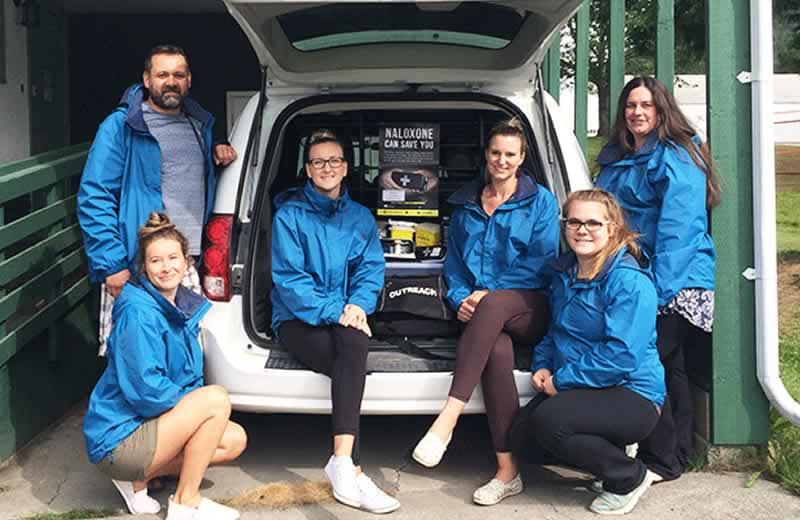Thursday, August 31 marks International Overdose Awareness Day (IOAD), a day that aims to raise awareness of overdose and reduce the stigma of drug-related death. Since the recent rise in overdose deaths, Northern Health staff and physicians, as well as community partners, have responded quickly in providing take home naloxone training and naloxone kits to people at risk of overdose as well as their friends and family members.
In 2017 alone, records show 105 naloxone kits refilled in Northern BC – that’s 105 kits used and 105 lives saved thanks to training and dispensing taking place in our region!
Over the course of the last year, staff at the 41 take home naloxone sites across Northern BC have had diverse experiences and developed unique strategies to get naloxone kits into the hands of those who need them. We want to share one of these experiences now, from the Intensive Case Management Team in the Northwest.
In what ways do you work with community members?
First and foremost, our team is non-judgmental and comes from a place of caring and support for individuals experiencing difficulties with substance use, regardless of their history. We work at street level with many clients, building rapport over time, providing wellness checks, harm reduction supplies, and supporting clients with access to various services. Our team also attends shelters, clients' homes, and conducts meetings within the office as well, based on what the community member is comfortable with. For some community members, it takes time for trust to form to ask for services, including take home naloxone or harm reduction supplies.
What’s the message to your audience?
We try to convey that our intentions come from a place of caring and that we hope to help keep them healthy and safe, not to judge or push for a change that they may not want or be ready for. We’re humble and recognize the immense value of lived experience in the work we do.
Our team tries to be flexible and take the direction from the individual we’re working with and support them in their journey, whatever journey that may be. We help empower them to access resources based on their own choices to reduce harms, and our team truly believes in the work they’re doing and the people they engage with.
How do you train people to use naloxone and/or when dispensing kits?
It really depends on the audience, but we maintain that we’re adaptable and that the client can take the lead. This means to be effective, sometimes our strategies toward naloxone training have to be pretty fluid.
Recreating life-like scenarios dealing with overdose, similar to if you were learning CPR training, has been an effective way of teaching individuals the steps to how to handle an overdose scenario. Diving into the realities of what people may see if they witness or come across someone who has overdosed can be unsettling, so we make sure to create a safe space for individuals to ask questions and practice drawing up and injecting the medication. Take home naloxone is comparable to having a first aid kit, and our team respects a person’s privacy around their use of it or the use of it on someone close to them.
Our most important training assets, of course, are our amazing peers who champion take home naloxone. They hand out their cards, nurture relationships with the at-risk population, and let them know where they can get naloxone, training, and other resources. They work within the community and seize any opportunity to offer naloxone training and kits!
Can you tell us about the experience you’ve had when developing community partnerships to dispense naloxone?
The support we’ve received from community partnerships has been awesome. We started building relationships within the community by going out and introducing our team, and then created a space for collaborative dialogue amongst Northern Health partners and other community agencies. Our team provides support to community agencies if they are wanting assistance navigating naloxone information and access to take home naloxone kits. In turn, the community service providers are able to alert us when a person is ready and willing to receive services.
We’re very thankful our partners have been open to welcoming us into their space to work alongside them in service provision, as this is where the clients are and feel most comfortable. Partnering with various agencies and various emergency responders has helped us better connect with individuals that may be at risk of overdose, which has proved to be invaluable when it comes to helping people in a timely manner.
Where can naloxone and other resources be found?
Naloxone kits are available to be dispensed for free to community members at risk for overdose and their friends and family members. The more naloxone kits we can get out into the community, the better equipped our community members are to respond to an overdose and save a life!
Harm reduction sites supply naloxone and other health and wellness resources – get to know the one in your community! Visit the Northern Health overdose prevention page for valuable overdose information, including how to recognize overdose and the SAVEME steps to help in an overdose situation.














Comments